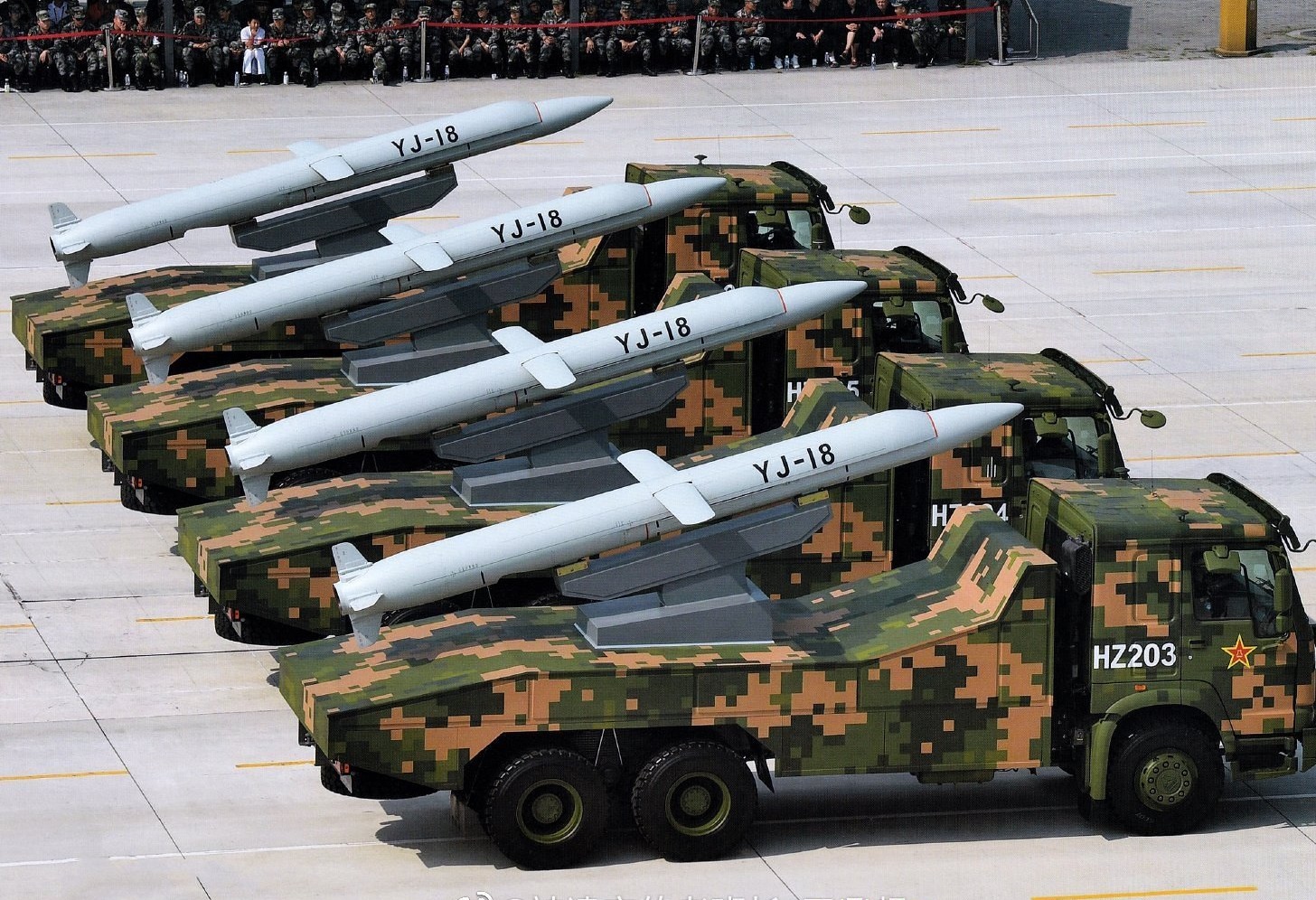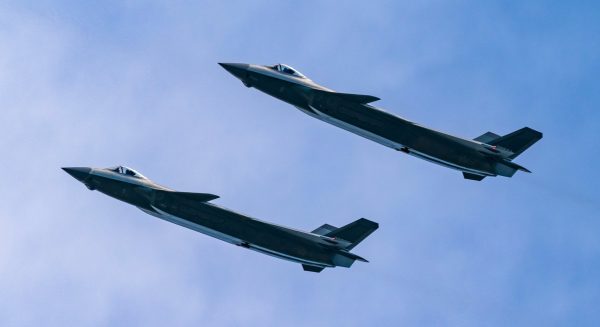China’s ‘Carrier-Killer’ Missiles, J-20 Jets Gives Beijing A Decisive Edge Over The US In Indo-Pacific: US Experts
ByParth Satam
September 5, 2021
Far East Asia is considered the next global flashpoint. With two superpowers — the US and China — flexing their military muscles in the disputed South China Sea (SCS), this could very well turn into a conventional war – an outcome the world dreads.
The region has three major conflict zones in the same contiguous geography – the Korean Peninsula, the Taiwan Strait, and SCS. Each of these has China as a party to the dispute and the US in the opposing camp, where any minor clash on any one of the issues could possibly ignite the other two.
However, it would be prudent to take an overview of how the countries fare against one another and which has an edge over the other, for an informed opinion on the issue.
China’s ‘Home Advantage’
Experts say China holds the ‘home advantage’ in the South China Sea, where physical control over some of the islands in addition to artificial features in the Spratlys and Senkaku (or Diaoyu in Chinese) allows it to defend them more successfully. Moreover, being close to the mainland allows better logistics flow that would support a long war.

China’s YJ-18 anti-ship cruise missile.
Second, China’s ‘Anti-Access/Area Denial (A2/AD)’ doctrine has influenced the development of ultra-long-range weapons systems that knocks out enemy platforms from afar and prevents close combat.
Based on the concept of “not allowing the enemy to come close to the mainland”, China has developed missiles that outrange any of the US weapons in that class.
The YJ-18 and YJ-12 supersonic anti-ship cruise missiles (range 540 km) and the PL-15 beyond visual range air-to-air missile (300 km), outrange the US’ subsonic 240-km range Harpoons and the 161-km AIM 190D.

PLA Air Force J-20 fighter jets patrol in the East China Sea Air Defense Identification Zone. (via Twitter)
The PL-15, combined with the J-20, experts believe would be used in ‘sniping mode’ where the aircraft will slip past fighter screens using a combination of stealth and jamming and knock out enemy airborne early warning, transport, and air-to-air refueling aircraft.
This degrades the logistical and surveillance capability of the adversary, instead of facing off its main fighting forces head-on.
US Carriers Could Be Sitting Ducks
Their pride and joy, the DF-21D missile (range 1,500 km) that threaten US aircraft carriers, operate on a similar philosophy. Called the ‘carrier killer’, the missile is totally unconventional, where it follows a ballistic trajectory like a strategic nuclear missile, leaves the atmosphere, and re-enters it to release a re-entry vehicle that propels down to hit an aircraft carrier.
The anti-ship ballistic missile (ASBM) is the first (and probably the only one) of its class. The unorthodox system and doctrine had left the US Navy at a complete loss.
“We are at a disadvantage with regard to China today in the sense that China has ground-based ballistic missiles that threaten our basing in the Western Pacific and our ships,” former US Pacific Command (PACOM, now INDOPACOM) commander Admiral Harry Harris, said in testimony before the US Senate Armed Services Committee in March 2018.
Harris also admitted that the US has “no equivalent” to missiles like the 4,000 km range DF-26 ballistic missile that can strike US bases at Guam. US bases in South Korea and Japan are meanwhile threatened by the 1,500 km range CJ-10 land-attack cruise missile, according to Pentagon estimates.
While experts believe the DF-21D to be unsuccessful without well-networked surveillance and targeting infrastructure, China is well on its way to develop that too.
Former US Marine Corps Officer Robert Haddick and visiting Senior Fellow at the Mitchell Institute for Aerospace Studies tells Reuters that it is a “very big gap”, adding “China’s anti-ship missile capability exceeds those of the United States in terms of range, speed, and sensor performance.”
Does The US Have Capacity Advantage?
While the US does exceed in capacity since the Arleigh Burke and Ticonderoga carry 96 and 122 Vertical Launch Silos (VLS) cells, as against the Type 052 and Type 55’s 64 and 112 VLS.
This leaves the ‘capacity’ advantage redundant since the Chinese side can fire first from a distance that is outside the range of US ships.
“The range disadvantage ends up being decisive. The US does not get a chance to exploit its capacity advantage. What could US ships be launching in response? At the ranges we are talking about, nothing,” former USN officer Bryan Clark, currently with the Center for Strategic and Budgetary Assessments, told Business Insider.
Third, experts also warn against merely increasing US force presence in the Western Pacific without securing basing rights with countries to host them. Without bases, the US would have poor aircraft sortie generation rates, bigger naval ship repair timelines, and slower troop redeployments.
For instance, the Philippines has decided to terminate the Visiting Forces Agreement (VFA) with the US, which envisaged US forces based on islands controlled by Manila in Scarborough Shoal.
This makes the South China Sea (SCS) even farther away for the US military, which would have to travel all the way from Japan. Japan itself is seeing Okinawans protesting the US military base there, demanding American forces vacate the island.
“We are playing an away game against China. For years the Blue Team has been in shock because they didn’t realize how badly off they were in a confrontation with China.”

 eurasiantimes.com
eurasiantimes.com
ByParth Satam
September 5, 2021
Far East Asia is considered the next global flashpoint. With two superpowers — the US and China — flexing their military muscles in the disputed South China Sea (SCS), this could very well turn into a conventional war – an outcome the world dreads.
The region has three major conflict zones in the same contiguous geography – the Korean Peninsula, the Taiwan Strait, and SCS. Each of these has China as a party to the dispute and the US in the opposing camp, where any minor clash on any one of the issues could possibly ignite the other two.
However, it would be prudent to take an overview of how the countries fare against one another and which has an edge over the other, for an informed opinion on the issue.
China’s ‘Home Advantage’
Experts say China holds the ‘home advantage’ in the South China Sea, where physical control over some of the islands in addition to artificial features in the Spratlys and Senkaku (or Diaoyu in Chinese) allows it to defend them more successfully. Moreover, being close to the mainland allows better logistics flow that would support a long war.

China’s YJ-18 anti-ship cruise missile.
Second, China’s ‘Anti-Access/Area Denial (A2/AD)’ doctrine has influenced the development of ultra-long-range weapons systems that knocks out enemy platforms from afar and prevents close combat.
Based on the concept of “not allowing the enemy to come close to the mainland”, China has developed missiles that outrange any of the US weapons in that class.
The YJ-18 and YJ-12 supersonic anti-ship cruise missiles (range 540 km) and the PL-15 beyond visual range air-to-air missile (300 km), outrange the US’ subsonic 240-km range Harpoons and the 161-km AIM 190D.
The YJ-18 is carried on Type 052 and Type 055 guided-missile destroyers, while US Navy’s Ticonderoga-class cruisers and Arleigh Burke-class destroyers carry the Harpoons and the surface-to-air SM-6s, the latter that can reach between 230 and 250 km.

PLA Air Force J-20 fighter jets patrol in the East China Sea Air Defense Identification Zone. (via Twitter)
The PL-15, combined with the J-20, experts believe would be used in ‘sniping mode’ where the aircraft will slip past fighter screens using a combination of stealth and jamming and knock out enemy airborne early warning, transport, and air-to-air refueling aircraft.
This degrades the logistical and surveillance capability of the adversary, instead of facing off its main fighting forces head-on.
US Carriers Could Be Sitting Ducks
Their pride and joy, the DF-21D missile (range 1,500 km) that threaten US aircraft carriers, operate on a similar philosophy. Called the ‘carrier killer’, the missile is totally unconventional, where it follows a ballistic trajectory like a strategic nuclear missile, leaves the atmosphere, and re-enters it to release a re-entry vehicle that propels down to hit an aircraft carrier.
The anti-ship ballistic missile (ASBM) is the first (and probably the only one) of its class. The unorthodox system and doctrine had left the US Navy at a complete loss.
“We are at a disadvantage with regard to China today in the sense that China has ground-based ballistic missiles that threaten our basing in the Western Pacific and our ships,” former US Pacific Command (PACOM, now INDOPACOM) commander Admiral Harry Harris, said in testimony before the US Senate Armed Services Committee in March 2018.
Harris also admitted that the US has “no equivalent” to missiles like the 4,000 km range DF-26 ballistic missile that can strike US bases at Guam. US bases in South Korea and Japan are meanwhile threatened by the 1,500 km range CJ-10 land-attack cruise missile, according to Pentagon estimates.
While experts believe the DF-21D to be unsuccessful without well-networked surveillance and targeting infrastructure, China is well on its way to develop that too.
Former US Marine Corps Officer Robert Haddick and visiting Senior Fellow at the Mitchell Institute for Aerospace Studies tells Reuters that it is a “very big gap”, adding “China’s anti-ship missile capability exceeds those of the United States in terms of range, speed, and sensor performance.”
Does The US Have Capacity Advantage?
While the US does exceed in capacity since the Arleigh Burke and Ticonderoga carry 96 and 122 Vertical Launch Silos (VLS) cells, as against the Type 052 and Type 55’s 64 and 112 VLS.
This leaves the ‘capacity’ advantage redundant since the Chinese side can fire first from a distance that is outside the range of US ships.
“The range disadvantage ends up being decisive. The US does not get a chance to exploit its capacity advantage. What could US ships be launching in response? At the ranges we are talking about, nothing,” former USN officer Bryan Clark, currently with the Center for Strategic and Budgetary Assessments, told Business Insider.
Third, experts also warn against merely increasing US force presence in the Western Pacific without securing basing rights with countries to host them. Without bases, the US would have poor aircraft sortie generation rates, bigger naval ship repair timelines, and slower troop redeployments.
For instance, the Philippines has decided to terminate the Visiting Forces Agreement (VFA) with the US, which envisaged US forces based on islands controlled by Manila in Scarborough Shoal.
This makes the South China Sea (SCS) even farther away for the US military, which would have to travel all the way from Japan. Japan itself is seeing Okinawans protesting the US military base there, demanding American forces vacate the island.
Finally, Pentagon-commissioned war games by the Rand Corporation have repeatedly ended in devastating defeats for the ‘Blue Team’ (US forces). According to former Deputy Assistant Secretary for Defence David Ochmanek, China can just swarm US and Taiwanese forces with thousands of ships, fishing craft, barges, aircraft, and missiles to overwhelm USN submarines, Harpoons and Long-Range Anti-Ship Missiles (LRSAM).
“We are playing an away game against China. For years the Blue Team has been in shock because they didn’t realize how badly off they were in a confrontation with China.”

China's 'Carrier-Killer' Missiles, J-20 Jets Give Beijing A Decisive Edge Over The US In Indo-Pacific: US Experts
Far East Asia is considered the next global flashpoint. With two superpowers — the US and China — flexing their military muscles in the disputed South China Sea (SCS), this could very well turn into a conventional war – an outcome the world dreads. US, India Ink Landmark Pact To Develop Next-Gen...
 eurasiantimes.com
eurasiantimes.com






